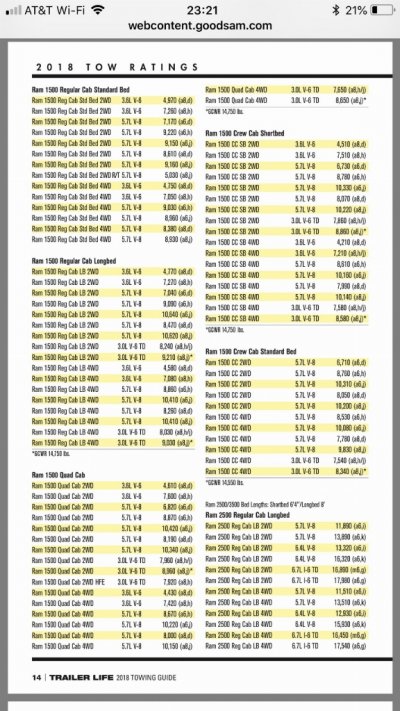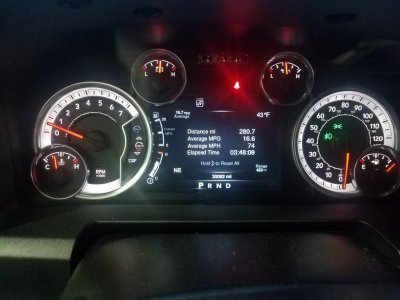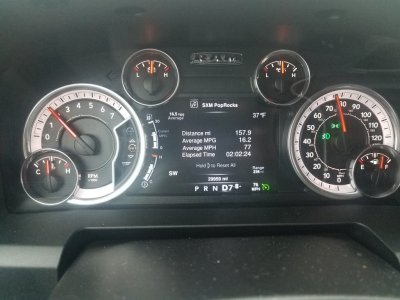Not so great WKU...
Unless you are just getting off the freeway in that pic, 74MPH average is kinda fast too.
Do you have bigger tires too?
I'm betting cold weather/winter gas is also a good part of your poor mileage equation...
Check this out:
https://www.metrompg.com/posts/winter-mpg.htm
Cold weather fuel consumption can be dramatically worse than in warm temperatures.
How much worse?
Have a gander at these calculations for a Honda Civic hybrid at 60 MPH in varying ambient temperatures (the winter effects on a hybrid are even worse than an all gas vehicle):
MPH-----AMBIENT-TEMP-----MPG (US)
60------------95----------52.98
60------------85----------52.62
60------------75----------51.16
60------------65----------49.12
60------------55----------47.22
60------------45----------44.67
60------------35----------43.05
60------------25----------41.54
60------------15----------39.41
60------------05----------38.09
Look at the extremes: the coldest MPG is
28% lower than the warmest. (
Source.)
My own experience supports this: 12.5% worse mileage during the colder half of the year (Oct 15 to Apr 15) than for the warmest half (Apr 15 - Oct 15), on average 2002-2004 in my 1989 Accord. Comparing just the warmest months (Jun-Aug) to the coldest (Dec-Feb), the difference is even more apparent - 21.2% worse (2002).
Why so bad? Off the top of my head, I could think of a couple of reasons to explain it, but together they didn't seem significant enough to account for the magnitude of the change. With this mystery to solve, I hit Google. And here's what I learned...
9 reasons your winter fuel economy bites
1. More idling
This should be a no-brainer, yet parked idling cars are a common sight in cold weather. Resist the temptation to idle your car to warm it up. An idling engine gets 0 mpg. Consider also that idling the engine does nothing to warm up the tires and drivetrain.
Even in the coldest weather, you can begin driving after 30 seconds from a cold start - keep speeds low/moderate and use gentle acceleration until the temperature gauge starts to climb (
source).
2. Low tire pressure
Of course you're smart enough to keep up your tire pressure as the temperature drops, right? A 10-degree (F) change in ambient temperature equates to a 1 psi change in tire pressure (
source). Fuel economy declines 0.4 percent for every 1 psi drop (
source).
3. Increased rolling resistance
Even if you're completely attentive to proper tire pressure, cold ambient temperatures will still cause your tires to return worse mileage. That's because a tire's shape isn't completely round - the sidewall bulges out at the bottom, and where the tread meets the road the small contact patch is actually flat. As the tire rotates, it constantly deforms to this shape, and this deformation requires more energy when the rubber is cold and hard. Rolling resistance at 0 degrees F is 20% greater than at 80 degrees (
source 1,
source 2).
4. Crappy road conditions
It's increased rolling resistance of another kind: driving through slush and snow. And then there's its wasteful polar (no pun intended) opposite: no friction at all! (A.K.A. wheelspin on ice.)
5. Lower average engine temperature
In the winter, an engine takes longer to reach operating temperature and cools off faster when shut off. Since the engine management system orders up a richer mixture when cold (proportionately more fuel in the air/fuel combination), more fuel is being burned overall.
A
block heater can offset this problem (improving fuel economy by 10% in sub-zero conditions -
source), as can garage parking, and combining trips (to minimize the number of cold/hot cycles).
6. Higher average lubricant viscosity
Engine oil thickens as it cools. So does transmission and differential fluids and even bearing grease. Significantly more energy is needed to overcome the added drag these cold lubricants cause.
Using synthetic fluids can address this problem, since their viscosity changes less at extreme temperatures than traditional mineral fluids.
7. Weaker gasoline
Gasoline doesn't vaporize readily at very cold temperatures. So oil companies formulate fuel differently for cold-weather markets in the winter. Unfortunately, the changes that provide better cold vaporization characteristics also result in less available energy for combustion. You won't get as far on a liter of winter gas as you will on a liter of summer gas. (
Source.)
8. Higher electrical loads
In colder temps, you use electrical accessories more often:
- lights (in higher lattitudes it's darker in the winter)
- rear window defroster (because it's easier than using the ice scraper, right?)
- heater blower motor (I don't have a/c, so this isn't balanced out during warm conditions); heated seats/mirrors
- windshield washer pump (because it's easier than using the ice scraper, right? And for frequently cleaning off dirty road spray.)
9. More aerodynamic drag
No, I'm not referring to the layer of snow you're too lazy to brush off the top of the car (though that would hurt mpg too).
A vehicle�s aerodynamic drag is proportional to air density, and the density increases as temperature drops. For every 10 degree F drop in temperature, aerodynamic drag increases by 2% (
source).




